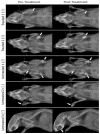Nicotinamide treatment in a murine model of familial tumoral calcinosis reduces serum Fgf23 and raises heart calcium
- PMID: 25007710
- PMCID: PMC4157335
- DOI: 10.1016/j.bone.2014.06.036
Nicotinamide treatment in a murine model of familial tumoral calcinosis reduces serum Fgf23 and raises heart calcium
Abstract
Mutations in the GALNT3 gene result in familial tumoral calcinosis, characterized by persistent hyperphosphatemia and ectopic calcific masses in soft tissues. Since calcific masses often recur after surgical removal, a more permanent solution to the problem is required. Nicotinamide is reported to lower serum phosphate by decreasing sodium-dependent phosphate co-transporters in the gut and kidney. However, its effectiveness in tumoral calcinosis remains unknown. In this study, we investigated nicotinamide as a potential therapy for tumoral calcinosis, using a murine model of the disease-Galnt3 knockout mice. Initially, five different doses of nicotinamide were given to normal heterozygous mice intraperitoneally or orally. Treatment had no effect on serum phosphate levels, but serum levels of a phosphaturic hormone, fibroblast growth factor 23 (Fgf23), decreased in a dose-dependent manner. Subsequently, high-dose nicotinamide (40mM) was tested in Galnt3 knockout mice fed a high phosphate diet. The radiographic data pre- and post-treatment showed that nicotinamide did not reverse the calcification. However, the treatment retarded calcification growth after 4weeks, while in the untreated animals, calcifications increased in size. The therapy did not affect serum phosphate levels, but intact Fgf23 decreased in the treated mice. The treated mice also had increased calcium in the heart. In summary, nicotinamide did not alter serum phosphate levels, likely due to compensatory decrease in Fgf23 to counteract the phosphate lowering effect of nicotinamide. Although increased calcium accumulation in the heart is a concern, the therapy appears to slow down the progression of ectopic calcifications.
Keywords: Calcification; Fgf23; Nicotinamide; Phosphate; Tumoral calcinosis.
Copyright © 2014 Elsevier Inc. All rights reserved.
Figures




References
-
- Topaz O, Shurman DL, Bergman R, Indelman M, Ratajczak P, Mizrachi M, Khamaysi Z, Behar D, Petronius D, Friedman V, Zelikovic I, Raimer S, Metzker A, Richard G, Sprecher E. Mutations in GALNT3, encoding a protein involved in O-linked glycosylation, cause familial tumoral calcinosis. Nat Genet. 2004;36:579–81. - PubMed
-
- Ichikawa S, Baujat G, Seyahi A, Garoufali AG, Imel EA, Padgett LR, Austin AM, Sorenson AH, Pejin Z, Topouchian V, Quartier P, Cormier-Daire V, Dechaux M, Malandrinou F, Singhellakis PN, Le Merrer M, Econs MJ. Clinical variability of familial tumoral calcinosis caused by novel GALNT3 mutations. Am J Med Genet A. 2010;152A:896–903. - PMC - PubMed
-
- Ichikawa S, Lyles KW, Econs MJ. A novel GALNT3 mutation in a pseudoautosomal dominant form of tumoral calcinosis: evidence that the disorder is autosomal recessive. J Clin Endocrinol Metab. 2005;90:2420–3. - PubMed
-
- Benet-Pagès A, Orlik P, Strom TM, Lorenz-Depiereux B. An FGF23 missense mutation causes familial tumoral calcinosis with hyperphosphatemia. Hum Mol Genet. 2005;14:385–90. - PubMed
Publication types
MeSH terms
Substances
Grants and funding
LinkOut - more resources
Full Text Sources
Other Literature Sources
Molecular Biology Databases

